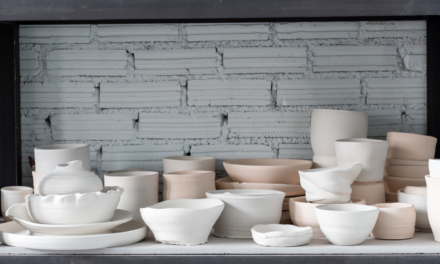What is Silicosis – Hidden Dangers of Working with Clay at Home
What is Silicosis – Hidden Dangers of Working with Clay at Home
Pottery can be a relaxing, enjoyable pastime for many artists and hobbyists, but what if they were to know that this activity could potentially put them in danger? It is valuable for potters of all skill levels to educate themselves on Silicosis, a chronic illness commonly known as Potter’s Lung or Potter’s Rot to the pottery community. This damaging disease can easily be prevented with safe practices in the pottery studio, and these precautions will also save the quality of pottery projects.
Continue reading to learn more about causes and symptoms of Silicosis, how silica dust can affect your pottery work, and simple preventative solutions to implement in your studio.
What Is Silicosis?

Silicosis is simple in concept, but this illness can pack a punch on a potter’s lungs. The lung disease is caused by continuous breathing in of silica dust found in clay. The silica dust particles enter the lungs and cling to its tissue, causing the immune system to attack the particles. This prompts inflammation and development of scar tissue, deteriorating the lungs over time. Silicosis is chronic, meaning there is no cure; once silica exposure is ensued on the lungs, damages are irreversible.
Common symptoms associated with Silicosis include chronic cough, difficulty breathing, shortness of breath during exertion, fatigue, fever, weight loss, and chest pains. Treatment can lessen the severity of everyday symptoms, but lack of any remedy can lead to worse diseases like Pulmonary Fibrosis, lung cancer, and Chronic Obstructive Pulmonary Disease (COPD).
The one positive thing about Potter’s Lung is that it is easily preventable if you instill safe practices and precautions from the start of your pottery journey. Knowing the ways to reduce silica dust’s ability to sneak into your lungs can save you from this pretty scary sickness.
Where Does Silica Dust Come From?
Silica dust is a common component in rock, sand, and clay, making it especially relevant to pottery activities. This very fine dust can contain other kinds of elements such as copper and chemicals from the clay itself, which can have their own dangerous side effects on your body. To put it plainly, silica dust is almost everywhere within the enclosed space of a pottery studio, making it hard to avoid. It floats up in the air while mixing dry clay, settling on shelves, tables, floors, and the potter, himself. Silica dust is produced in jobs involving construction or masonry, too, though these have the advantage of being in larger facilities and outdoor spaces that give the dust more room to disperse; a small pottery studio creates a concentrated environment that traps in the dust, which puts a potter at greater risk of breathing in the silica while working.
Effects of Silica Dust on Pottery
If you think silica dust only affects the potter, don’t be mistaken. The dust can ruin unfinished work that waits on storage shelves for prolonged periods of time. As the dust settles on surfaces over time, it easily coats pottery like bisque work that hasn’t been glazed yet. It is a good recommendation to dust off any older pieces of pottery before glazing them to avoid any deterioration or unwanted texture on your ceramics. Irregular cleaning and dusting of your pottery studio can lead to this unwanted damage of a potter’s work.
How Can Potters Prevent Silicosis?
There are a few practices that should become standard for you to perform as a smart potter to lessen your chance of developing Silicosis, and you might be able to save the quality of your pottery while you’re at it. The first step is to make a routine of cleaning your studio, especially after mixing clay. The key to limiting the amount of dust you kick up in the air while cleaning is to take the wet approach. Mop floors instead of sweeping to trap the dust within the wet mop. The same goes for wiping down surfaces, which can be done using a large sponge or wet cloth. With more regular cleaning of all surfaces, a potter can minimize the amount of silica accumulation throughout a studio, reducing the degree of exposure the potter will experience and the build-up of dust on unfinished work. Another good practice to remember while cleaning is to avoid any excessive shaking of towels and aprons within your studio to prevent extra dust from entering the air space.
When dealing with dust particulates, this weightless substance directly impacts the indoor air quality of a space. The only way to actually clean the air of silica dust that hasn’t settled is with some form of air filtration that will suck up this contaminant and replace it with fresh, filtered air. A portable air purifier is a valuable investment for pottery studios due to the associated high risk of exposure and lung damage from Silicosis. Providing an additional means of filtration to your pottery studio can do the heavy cleaning that a simple HVAC system is incapable of. Quality air purifiers will capture the silica dust particles and retain them in their filters, which can significantly reduce a potter’s exposure to the silica, further lessening their chances of developing the illness.
The EnviroKlenz Air Systems are worth considering for a pottery studio, as these portable purifiers capture and destroy 99.9% of airborne pathogens and pollutants, backed by third-party testing and accomplished through a double filtration system of the EnviroKlenz Air Cartridge and a HEPA filter. Utilizing patented earth-mineral technology, the Air System locks in any particulate matter that enters its unit, providing superior indoor air quality in return. This beneficially impacts the health of a potter by promoting a cleaner, safer environment to work in.
Early prevention is key when avoiding the threat of Silicosis. If a potter considers the importance of their studio’s indoor air quality, and how this directly impacts the potential and potency of silica dust exposure, they would be smart to instill safety measures like air purification to their studio. Your health is worth the investment, and this precaution could allow any potter to worry less about the health of their lungs and spend more time molding clay into beautiful pottery.

Now that you have all the key elements for designing the perfect home pottery studio, you’ll be molding clay and firing pottery in no time. Let this be a guide for approaching pottery at home, and more importantly, approaching your artistic ventures in a safe, healthy way.
UV Mobile Air System

✓ Patented earth mineral technology works to attack VOCs and break them down on a compound level
✓ No chemicals or masking agents

✓ Will not release any chemicals back into your environment
✓ UVC lamps are continuously shining on the collected organisms with high effeciency of kill and destruction
EnviroKlenz® Medical Disclaimer:
“Any information that is provided on this website is not for the use by any commercial or personal entity without expressed written consent of the blog author. The material and statements illustrated within this blog are not intended to diagnose, treat, cure, or prevent any diseases or medical conditions. Nor does the author in any way guarantee or validate the validity, totality, or efficacy of any claims and will therefore not be held responsible for the content of any claims. Always consult your medical physician for any specific medical advice or recommendations.”




Comments
Post a Comment